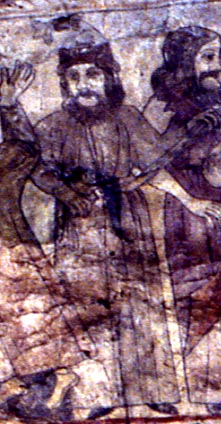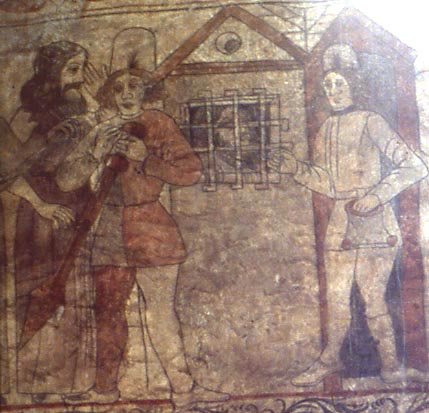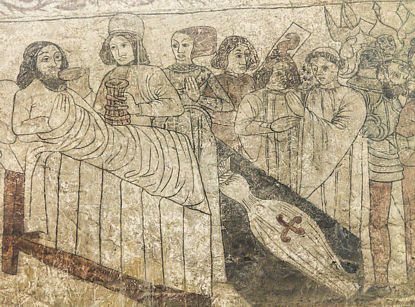Pickering, N Yorkshire (†York) C.15
The Seven Works of Mercy


The Works of Mercy at Pickering have been restored many times, but this is a complete sequence, and all the scenes are clear. They are arranged in strip format, bordered by bands of scrollwork, high on the south wall just below the clerestory windows. In this case the Works are performed by a man, although there is a woman in attendance in Visiting the Sick. Feeding the Hungry, at the left above, features two objects suggesting doughnuts – ring-shaped loaves, no doubt – and two men are shown receiving them. They seem rather too well-dressed to be beggars, and are almost certainly intended as pilgrims, towards whom charity was obligatory. Detail is bleached out by strong light from the clerestory window above, but at close quarters a cockleshell pilgrim badge, emblem of the shrine of St James the Great at Compostela, is identifiable on the hat of the man at the right. Two (different?) men are shown in the next scene, one drinking from a bowl given to him by the man in the doorway holding a flagon.

Next to the right (photo right), Receiving the Stranger and Clothing the Naked are shown together, I think, and rather confusingly conflated. The man apparently falling into the doorway and seemingly supported by the charity-dispensing man standing to his left, is perhaps simply being welcomed in, or welcomed in and helped to put on the loose robe that he wears. To the right of this man though, and shown separately at the right, is another, facing forward, wearing a floppy conical cap and tying a sash around his waist in a very marked manner. He must also be part of Clothing the Naked rather than anything else. Matters are complicated though by a heavily bearded man next to the right, the sleeves of whose garment seem to have been torn out, leaving ragged edges at shoulder level. Although he faces right, he is perhaps the sash-tying man before receiving his new robe.

The rest of this scene (shown above left) is Visiting the Imprisoned, featuring a man with a spear – presumably a jailer – beside a small building with a grille on the window. Beyond to the right a man with a pouch at his belt hands something to a man, his head visible, inside the prison-house through the barred window. This particular way of painting the subject is unique on this site, where the imprisoned figures are invariably shown in the village stocks. Pickering is and was a town, with an ancient castle (Richard II was once imprisoned in it) as well as the church – this way of showing Visiting the Prisoner probably seemed the natural one. Next in the series is Visiting the Sick (right), with a man in bed offered a small bowl by another – possibly a doctor to judge by the object he holds, which seems to be a tall medicine jar.
A woman in a fashionable 15th century headdress is beside him. Finally comes Burying the Dead, with a tonsured priest blessing a shrouded corpse and two other men in attendance. The shroud has a red cross on it, and is gathered and tied on top of the head in a manner familiar from many 15th century Doom paintings. Immediately beyond to the right, the Pickering Passion Cycle, with Judas and Christ shown at the moment of betrayal, begins.
Other paintings at Pickering are on the site are the newly-added Life of St Catherine and St Christopher. The Martyrdom of St Edmund now has a new photograph.
Website for SS Peter & Paul, Pickering
¹ There are more possibly significant hat-badges here. It is tempting, given the mid/late 15th century date of these paintings, to see the plant-sprigs displayed on the hats of the guard and the man giving alms as emblems of Plantagenet loyalty – Elizabeth I herself had a gown embroidered with the planta genista broom-sprig, so the symbolism was still very much alive. But there are many other possible interpretations.